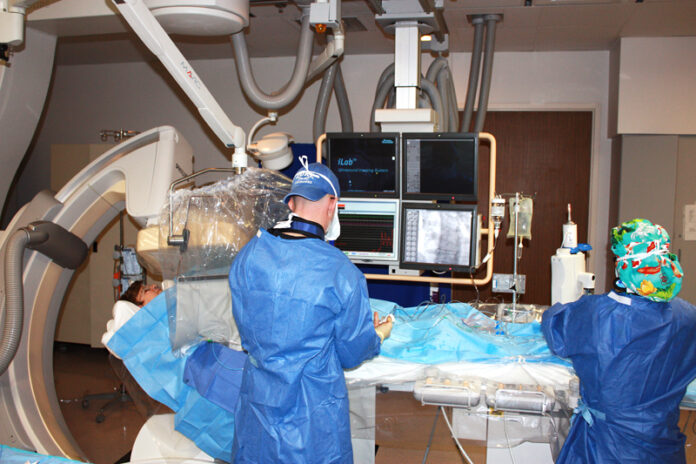
“Wrist May Be Route to Safer Heart Treatment”—reads the headline on the front page of the February issue of the Wall Street Journal. A local doctor is now offering this option to his patients who require cardiac catheterization to determine if they have a blocked artery. Conventional cardiac catheterization is done through an entry point in the groin which then requires the patient to lie very still for hours in order for the incision to heal. LewisGale‘s Dr. Richard Konstance recently demonstrated the wrist procedure and answered some questions, explaining why some doctors now prefer this option.
Why is doing heart catheterization through the wrist beneficial? While this is not a new approach to performing the procedure, with the improvement in technology (e.g. catheters with smaller diameters, better wires, and medicines that prevent spasm of the arteries in the wrist) we can now offer this to a broader population of patients. It used to be reserved for those patients in whom a groin approach was challenging such as those with peripheral artery disease (blocked arteries in the legs), obese patients, etc. The benefit is largely due to patient safety, most notably the risk of bleeding and major vascular complications as well as improved patient comfort and earlier time to ambulation. Most patients can sit up immediately following the procedure as opposed to what many compare to having to lie flat for 8 hours with a sandbag on their leg.
What do you think about the fact that it is recognized in the Wall Street Journal? In the beginning of this decade only a percent or two of coronary interventions were being performed via the wrist. Now it’s up to 8% or so. Whether it’s due to more cardiologists taking this approach or due to those of us who do radials doing more, I don’t know. It’s probably all of the above. The recognition in WSJ is a good thing. It’s likely to lead to patient-driven innovation and further adoption of the procedure by cardiologists who may be on the fence.
How will it change the field? Hopefully [it will stimulate] more innovation. Right now we are somewhat limited by the catheters and devices that are designed to be used from the groin. As demand for radial procedures increases, my hope is that we will see new products from industry. As someone who treats PAD, I would love to offer more patients treatment of their leg arteries from the wrist.
How long have you been in the Roanoke valley? I’ve been here for almost 5 months. A few others are doing this as well but I suspect I am currently doing the most in terms of volume. I’d say I do 85% of my heart catheterizations through the wrist–about 50 or 60 per month.
If you detect a problem, can you treat it during this procedure? Yes, we can place stents via this approach. The good thing is we can sometimes get patients home the same day.
What made you start using this method? Dr. Rao, who is quoted in WSJ article and a leader in this field, is a friend of mine. We trained together at Duke. Ironically neither of us had much exposure to this procedure in training. His story is that a patient came in critically ill and he was unable to gain access through the groin in a timely manner. Thereafter he made it a habit to do at least one radial case per day. My story relates to a (non-radial) late bleeding complication that was quite devastating. It’s exceedingly rare to have a life-threatening bleed from the wrist. You just put your finger on it and it eventually stops.”


